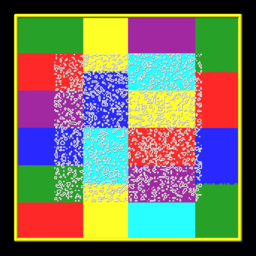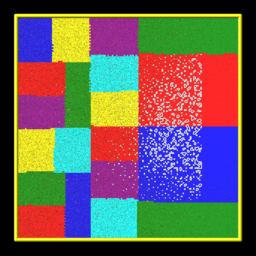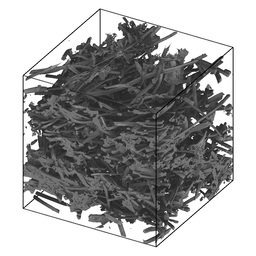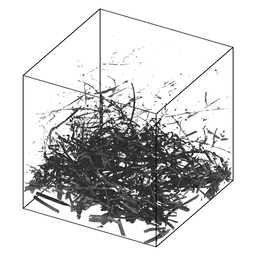fix ablate command¶
Syntax:¶
fix ID ablate group-ID Nevery scale source maxrandom
ID is documented in fix command
ablate = style name of this fix command
group-ID = ID of group of grid cells that contain implicit surfaces
Nevery = perform ablation once every Nevery steps
scale = scale factor to convert source to grid corner point value decrement
source = computeID or fixID or random
computeID = c_ID or c_ID[n] for a compute that calculates per grid cell values fixID = f_ID or f_ID[n] for a fix that calculates per grid cell values random = perform a random decrement
maxrandom = maximum per grid cell decrement as an integer (only specified if source = random)
Examples:¶
fix 1 ablate surfcells 0 0.0 random 10
fix 1 ablate surfcells 1000 10.0 c_tally
Description:¶
Perform ablation once every Nevery steps on a set of grid cell corner points to induce new implicit surface elements in those grid cells. This command is also used as an argument to the read_isurf command so that the grid corner point values it reads from a file can be assigned to and stored by each grid cell.
Here are simulation snapshots of 2d and 3d implicit surface models through which particles flow. Click on any image for a larger image. The 1st and 3rd images are the initial states of the porous media. The 2nd and 4th images are snapshots midway through an ablation simulation. In the 2d case, the colorings are by processor for sub-domains each owns. Particles flow from left to right. The implicit triangles for the 3d case were created via Marching Cubes (discussed on the read_isurf command doc page) from a tomographic image of a sample of NASA FiberForm (TM) material, used as a heat shield material on spacecraft. Particles flow from top to bottom.
The specified group-ID must be the name of a grid cell group, as defined by the group grid command, which contains a set of grid cells, all of which are the same size, and which comprise a contiguous 3d array. It must be the same as group-ID used with the read_isurf command, which specifies its Nx by Ny by Nz extent. See the read_isurf command for more details. This command reads the initial values for grid cell corner points, which are stored by this fix.
The specfied Nevery determines how often an ablation operation is performed. If Nevery = 0, ablation is never performed. The grid cell corner point values and the surface elements they induce will remain static for the duration of subsequent simulations.
The specified scale is a pre-factor on the specified source of ablation strength. It converts the per grid cell numeric quantities produced by the source (which may have associated units) to a unitless decrement value for the grid cell corner points, which range from 0 to 255 inclusive. A value of 255 represents solid material and a value of 0 is void (flow volume for particles). Values in between represent partially ablated material.
The source can be specified as a per grid cell quantity calculated by a compute, such as compute isurf/grid, e.g. the number of collisions of particles with the surfaces in each grid cell or the amount of energy transferred to the surface by the collisions. It can also be specified a per grid cell quantity calculated by a fix, such as fix ave/grid. That fix could time average per-grid cell quantities from per grid cell computes. In that case the scale factor should account for applying a time-averaged quantity at an interval of N steps.
For debugging purposes, the source can also be specified as random with an additional integer maxrandom value also specified. In this case, the scale factor should be floating point value between 0.0 and 1.0. Each time ablation is performed, two random numbers are generated for each grid cell. The first is a random value between 0.0 and 1.0. The second is a random integer between 1 and maxrandom. If the first random # < scale, then the second random integer is the decrement value for the cell. Thus scale is effectively the fraction of grid cells whose corner point values are decremented.
Here is an example of commands that will couple ablation to surface reaction statistics to modulate ablation of a set of implicit surfaces. These lines are taken from the examples/ablation/in.ablation.3d.reactions input script:
surf_collide 1 diffuse 300.0 1.0
surf_react 2 prob air.surf
compute 10 react/isurf/grid all 2
fix 10 ave/grid all 1 100 100 c_10*
dump 10 grid all 100 tmp.grid id c_101
global surfs implicit
fix ablate ablate all 100 2.0 c_101 # could be f_10
read_isurf all 20 20 20 binary.21x21x21 99.5 ablate
surf_modify all collide 1 react 2
The order of these commands matter, so here is the explanation.
The surf_modify command must come after the read_isurf command, because surfaces must exist before assigning collision and reaction models to them. The fix ablate command must come before the read_isurf command, since it uses the ID of the fix ablate command as an argument to create implicit surfaces. The fix ablate command takes a compute or fix as an argument, in this case the ID of the compute react/isurf/grid command. This is to specify what calculation drives the ablation. In this case, it is the compute react/isurf/grid command (or could be the fix ave/grid command) which tallies counts of surface reactions for implicit triangles in each grid cell. The compute react/isurf/grid react/isurf/grid command requires the ID of a surface reaction model, so that it knows the list of possible reactions to tally. In this case the reaction is set by the surf_react command, which must therefore comes near the beginning of this list of commands.
As explained on the read_isurf doc page, the marching cubes (3d) or marching squares (2d) algorithm is used to convert a set of grid corner point values to a set of implicit triangles in each grid cell which represent the current surface of porous material which is undergoing dynamic ablation. This uses a threshold value, defined by the read_isurf command, to set the boundary between solid material and void.
The ablation operation decrements the corner point values of each grid cell containing porous material. The marching cubes or squares algorithm is re-invoked on the new corner point values to create a new set of implicit surfaces, which effectively recess due to the decrement produced byt the ablative source factor.
The manner in which the per-grid source decrement value is applied to the grid corner points is as follows. Note that each grid cell has 4 (2d) or 8 (3d) corner point values. Except at the boundary of the 2d of 3d array of grid cells containing porous materials, each corner point is similarly shared by 4 (2d) or 8 (3d) grid cells.
Within each grid cell, the decrement value is subtracted from the smallest corner point value. Except that a corner point value cannot become smaller than 0.0. If this would occur, only a portion of the decrement is used to set the corner point to 0.0; the remainder is applid to the next smallest corner point value. And so forth on successive corner points until all of the decrement is used.
The amount of decrement applied to each corner point is next shared between all the grid cells (4 or 8) sharing each corner point value. The sum of those decrements is subtracted from the corner point, except that it’s final value is set no smaller than 0.0. All the copies of each corner point value are now identical.
Finally, no corner point value can be nearly equal to the marching cubes/squares threshold value, else line segments or triangles of zero or epsilon size will result. So corner points with values X where thresh-epsilon < X < thresh+epsilon are reset to thresh-epsilon. Thresh is defined by the read_isurf command. Epsilon is set to 1.0e-4 in src/fix_ablate.cpp. Note that this is on the scale of corner point values from 0 to 255.
Restart, output info:¶
No information about this fix is written to binary restart files.
This fix computes a global scalar and a global vector of length 2. The global scalar is the current sum of unique corner point values across the entire grid (not counting duplicate values). This sum assumes that corner point values are 0.0 on the boundary of the 2d or 3d array of grid cells containing implicit surface elements.
The 2 vector values are the (1) sum of decrement values for each grid cell in the most recent ablation operation, and (2) the # of particles deleted during the most recent ablation operation that ended up “inside” the newly ablated surface. The latter quantity should be 0. A non-zero value indicates a corner case in the marching cubes or marching squares algorithm the developers still need to address.
These values can be accessed by any command that uses global values from a fix as input. See Section 6.4 for an overview of SPARTA output options.
The scalar and vector values are unitless.
Restrictions:¶
This fix can only be used in simulations that define implicit surfaces.
Default:¶
none



